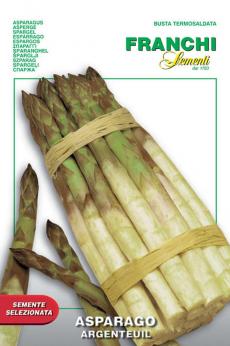
Asparagus Asparago Precoce d'Argenteuil
Arparagus Precoce d'Argenteuil. Early. Light green big spears with purplish scales. Asparagus beds produce for 20 or more years. Easy to grow; rust resistance. These are seeds; USDA will not allow import of root stock. Starting from seed means it takes an additional year to get your bed productive, but well worth the effort!.
Asparagus 'Precoce D'Argentuil’ or ‘Early Argenteuil‘ was listed by Vilmorin-Andrieux in 1885 as a selection from 'Giant Dutch Purple'. It is one of three subvarieties of Argenteuil (early, mid, and late) and is highly esteemed for its thick, rose-purple spears with tender tips and an excellent flavor. It is an excellent choice for the impatient gardener as it is earlier and hardier than most asparagus varieties, the spears are usually produced from seed struck plants in the second year and it will shoot earlier in the season than other varieties.
Choosing a site: Avoid frost pockets and exposed areas. Do not replant on an old asparagus bed as diseases may be a problem. Asparagus will grow on most soil types provided they are well drained. On heavy soils consider creating raised beds, acidic soils may need liming. Soil preparation is essential. Clear the ground of weeds. On heavily compacted soils consider double-digging, otherwise cultivate to a spade’s depth, incorporating well-rotted farmyard manure or good organic matter..
Planting: Sow indoors in Late Winter to Spring Soak the seeds in water overnight. Sow seeds singly into modules at a depth of ½".
They will germinate in 2 to 8 weeks depending on soil temperature. The optimum germination temperature is 60 to 85°F. After 12 to 14 weeks, they will be ready to be transplanted outdoors, do this no earlier than four weeks after the last spring frosts. Fork over the prepared area and dig a trench 12in wide and 8in deep. Work in well-rotted manure in the bottom, cover with 2" of the excavated soil and make a 4in ridge down the center of the trench. Place the crowns on top, spacing them 12 to18" apart (right). Leave 18" between rows and stagger the plants. Spread the roots evenly and fill in the trench, leaving the bud tips just visible. Water in and mulch with 2" of well-rotted manure.
Cultivation: Asparagus beds must be kept weed free - best done by hand as the shallow roots are easily damaged by hoeing. Mulching discourages weeds and retains moisture. Apply a general fertiliser in early spring and repeat once harvesting has finished. To avoid top-growth breaking off in wind and damaging the crown, use canes and twine either side of the row for support. Allow the foliage to yellow in autumn before cutting it down to 1".
Late frosts will cause distorted growth: protect with a double layer of fleece.
Harvesting: Do not harvest for the first 2 years. In the 3rd year, pick from mid-April for 6 weeks. To harvest, choose spears that are thicker than a pencil. Cut with a sharp knife 1" below the soil when they are no more than 7" tall. In warm weather, harvest every 2-3 days for best quality spears.
Troubleshooting: The main pests to affect asparagus are slugs and snails, and the larvae and adults of the asparagus beetle. Thin spindly shoots may be due to inadequate moisture, especially with young crowns. In established beds the cause is more likely to be overcropping or competition from weeds.
Companion Plants: Tomato, Parsley and Basil

In France, Asparagus D'Argentuil is the traditional variety used to create the popular white asparagus by blanching the plants. White asparagus, nicknamed ‘edible ivory’ and ‘white gold’ typically sells for two to three times as much as the green-skinned variety due to the high cost of production and the short season. However, it is simply created by mounding earth over the spears as they begin to push out of the ground, thus keeping them from sunlight and the photosynthesis that would turn them green. This noble stalk may cost a king's ransom for much of the year but when cultivated in the garden it is affordable for even us commoners and is uncommonly delicious.
